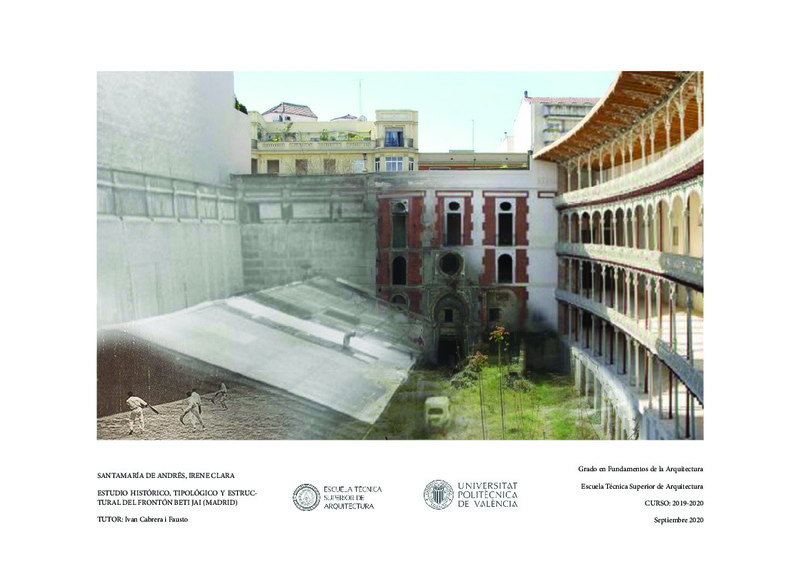JavaScript is disabled for your browser. Some features of this site may not work without it.
Buscar en RiuNet
Listar
Mi cuenta
Estadísticas
Ayuda RiuNet
Admin. UPV
Estudio histórico, tipológico y estructural del Frontón Beti Jai (Madrid).
Mostrar el registro sencillo del ítem
Ficheros en el ítem
| dc.contributor.advisor | Cabrera Fausto, Ivan
|
es_ES |
| dc.contributor.author | Santamaría de Andrés, Irene Clara
|
es_ES |
| dc.coverage.spatial | east=-3.6910215414016623; north=40.43111760799938; name=C. del Marqués del Riscal, 7, 28010 Madrid, Espanya | es_ES |
| dc.date.accessioned | 2022-02-21T11:18:51Z | |
| dc.date.available | 2022-02-21T11:18:51Z | |
| dc.date.created | 2020-09-17 | |
| dc.date.issued | 2022-02-21 | es_ES |
| dc.identifier.uri | http://hdl.handle.net/10251/181008 | |
| dc.description.abstract | [ES] La pelota vasca es un enraizado deporte de un territorio concreto, el País Vasco, que se ha expandido a lo largo de todo el mundo, siendo practicado tanto en Europa como en América de Sur. Quizá sea por su tradición, su espíritu deportivo, la emoción de los pelotaris partido tras partido, que consiguió despertar el interés de las clases más altas de finales del siglo XIX y principios del XX, cuando la propia realeza española, adoradores de este deporte, se lo traen consigo a Madrid. Los frontones se convirtieron en los centros de ocio de la cultura madrileña. Desgraciadamente, el auge de la pelota vasca en Madrid se desploma y los frontones se derriban o abandonan. Esto último fue lo que le ocurrió al edificio objeto de estudio en este trabajo, el frontón Beti Jai. Fue adoptando variedad de usos, cada cuál estropeándolo un poco más, casi alcanzando la situación de ruina. Finalmente, gracias a la reciente revalorización del patrimonio, al COAM y a la plataforma Salvemos el Frontón Beti Jai, formada por un heterogéneo grupo de personalidades relacionadas tanto con la arquitectura como con la pelota vasca, recupera su esplendor. Se realiza una cuidadísima investigación y análisis del estado del edificio para ser rehabilitado tal y cómo fue originalmente. Debido a las limitaciones de Seguridad Estructural vigentes en España a través del CTE, durante la rehabilitación es preciso realizar refuerzos en la estructura. El trabajo ubicará al lector en este contexto histórico, desarrollará la geometría y la construcción del edificio y, posteriormente, analizará la estructura original del proyecto, para así determinar los elementos que no satisfacen los mínimos y comentar el refuerzo ejecutado. | es_ES |
| dc.description.abstract | [EN] Basque ball is a sport rooted in a specific territory, the Basque Country, which has expanded throughout the world, being practised both in Europe and South America. Perhaps it is because of its tradition, its sportsmanship, the excitement of the pelotaris match after match that it managed to arouse the interest of the upper classes at the end of the 19th At and beginning of the 20th century, when the Spanish royalty themselves, worshippers of this sport, brought it to Madrid. Fronton courts became the leisure centres of Madrid's culture. Unfortunately, the boom of Basque ball in Madrid collapses and its courts are demolished or abandoned. That last circumstance happened to the building under study in this work, the Beti Jai Basque ball court. It adopted a variety of uses, each one spoiling it a little more, almost reaching the situation of ruin. Finally, thanks to the recent revaluation of the heritage, the COAM and the platform Salvemos el Frontón Beti Jai were formed by a heterogeneous group of personalities related to architecture, and Basque pelota recovers its splendour. Meticulous research and analysis of the state of the building are carried out to rehabilitate it as it was initially. Due to the limitations of Structural Safety in Spain compiled in the CTE, it is necessary to make reinforcements in the structure during the rehabilitation. The work will place the reader in this historical context, develop the building's geometry and construction, and, subsequently, analyse the original structure of the project to determine the elements that do not satisfy the minimums and comment on the reinforcement carried out. | es_ES |
| dc.format.extent | 63 | es_ES |
| dc.language | Español | es_ES |
| dc.publisher | Universitat Politècnica de València | es_ES |
| dc.rights | Reserva de todos los derechos | es_ES |
| dc.subject | Refuerzo | es_ES |
| dc.subject | Madrid | es_ES |
| dc.subject | Frontón Beti Jai | es_ES |
| dc.subject | Pelota vasca | es_ES |
| dc.subject | Estructura | es_ES |
| dc.subject | Rehabilitación | es_ES |
| dc.subject | Frontó Beti Jai | es_ES |
| dc.subject | Pilota basca | es_ES |
| dc.subject | Rehabilitació | es_ES |
| dc.subject | Reforç | es_ES |
| dc.subject | Fronton Beti Jai | es_ES |
| dc.subject | Basque ball | es_ES |
| dc.subject | Structure | es_ES |
| dc.subject | Rehabilitation | es_ES |
| dc.subject | Reinforcement | es_ES |
| dc.subject.classification | MECANICA DE LOS MEDIOS CONTINUOS Y TEORIA DE ESTRUCTURAS | es_ES |
| dc.subject.other | Grado en Fundamentos de la Arquitectura-Grau en Fonaments de l'Arquitectura | es_ES |
| dc.title | Estudio histórico, tipológico y estructural del Frontón Beti Jai (Madrid). | es_ES |
| dc.type | Proyecto/Trabajo fin de carrera/grado | es_ES |
| dc.rights.accessRights | Abierto | es_ES |
| dc.description.bibliographicCitation | Santamaría De Andrés, IC. (2020). Estudio histórico, tipológico y estructural del Frontón Beti Jai (Madrid). Universitat Politècnica de València. http://hdl.handle.net/10251/181008 | es_ES |
| dc.description.accrualMethod | TFGM | es_ES |
| dc.relation.pasarela | TFGM\116850 | es_ES |
Este ítem aparece en la(s) siguiente(s) colección(ones)
-
ETSA - Trabajos académicos [4445]
Escuela Técnica Superior de Arquitectura






